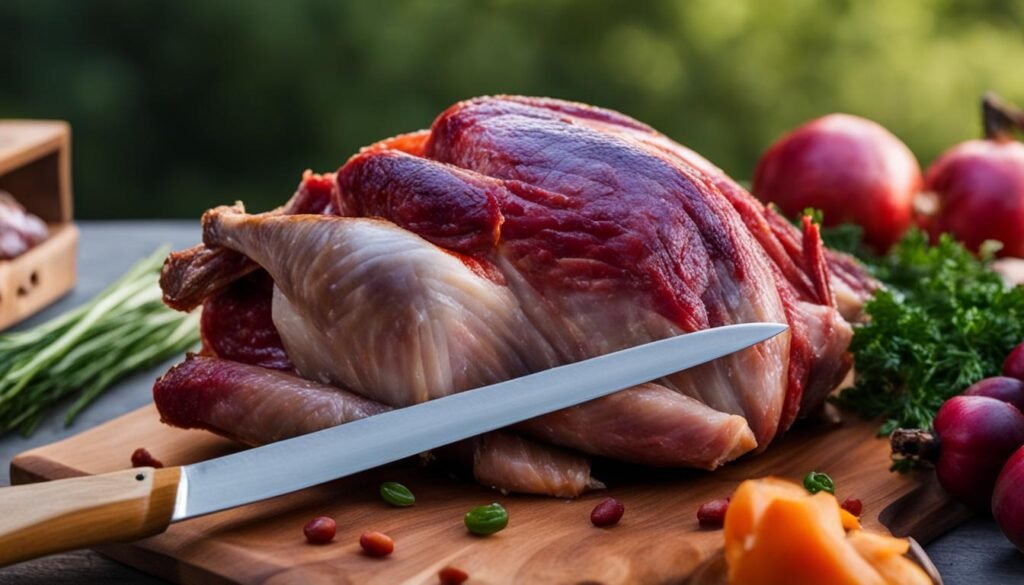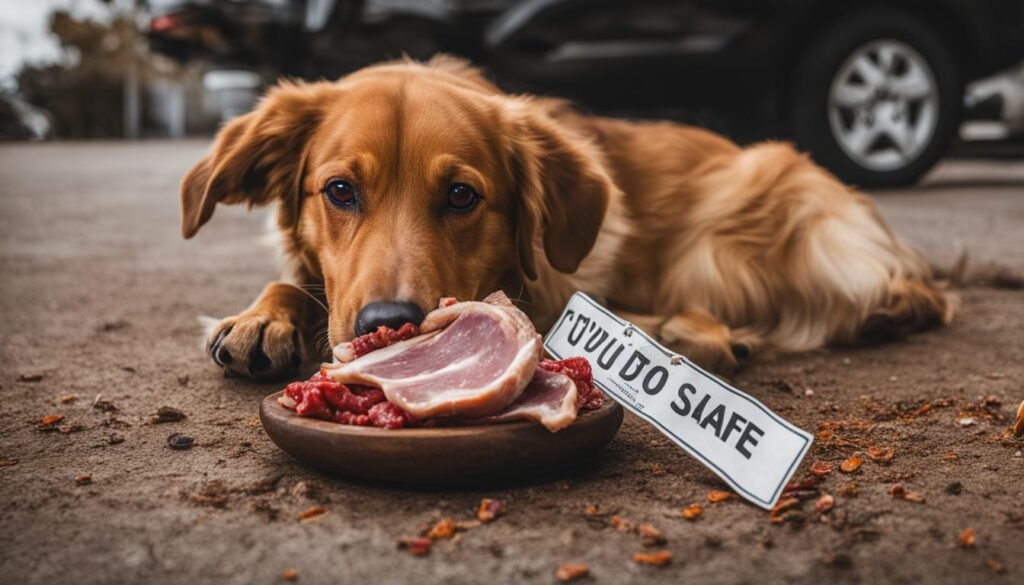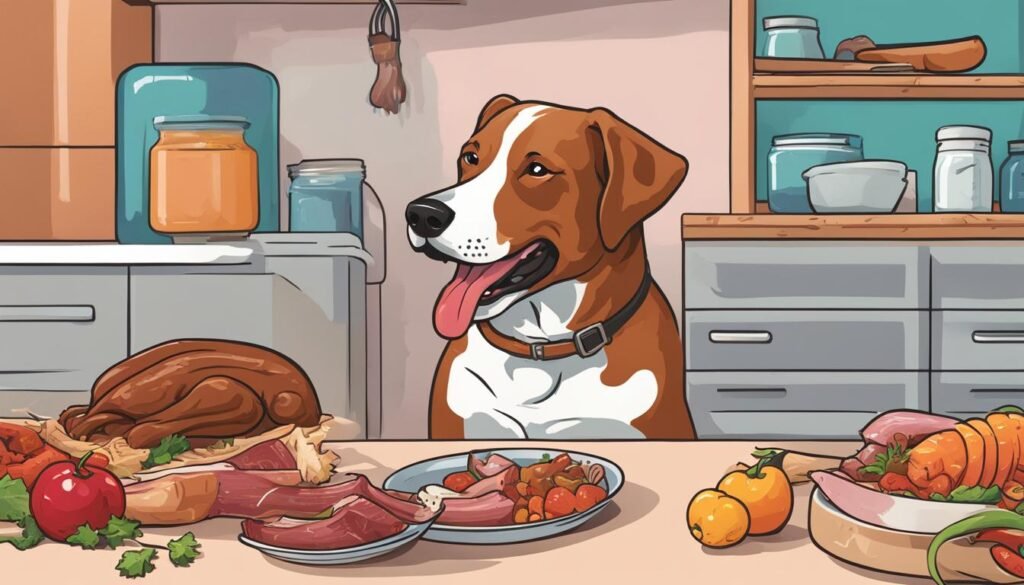As a devoted pet owner, I’ve always been curious about the various foods I can safely feed my furry friend. One question that often comes up is whether Can a Dog Eat a Raw Turkey Neck ?. So, I delved into the subject and discovered some interesting facts that I’d like to share with you. I’ll be discussing the safety of feeding raw turkey necks to dogs, the benefits of raw feeding, and some precautions to keep in mind.
Key Takeaways:
- Raw turkey necks can provide mental stimulation and dental benefits for dogs.
- However, there are risks associated with feeding turkey necks, including bacterial contamination and choking hazards.
- It’s important to buy free-range products with animal welfare accreditation and consider alternatives such as dental chews and chicken necks.
- Safe food handling practices should always be followed when feeding raw meat products.
- Consult with a veterinarian before making any significant dietary changes for your dog.
What Are Turkey Necks?
Turkey necks are a popular choice for dog owners looking to provide their pets with a natural and nutritious treat. They are the entire neck of a turkey, excluding the head, skin, and crop. Turkey necks contain a mix of bones, muscles, connective tissue, and the trachea. They are larger than duck and chicken necks, making them suitable for medium to giant breed dogs.
Feeding turkey necks to dogs can offer several benefits. Firstly, they provide mental stimulation and help satisfy a dog’s natural instinct to chew. Chewing on turkey necks can also help improve dental health by removing plaque and tartar buildup. Additionally, turkey necks contain chondroitin and glucosamine, which can support joint health in dogs.
When incorporating turkey necks into a dog’s diet, it is essential to source them from reputable farms that prioritize animal welfare. Look for free-range products with proper accreditation. It is also important to supervise chewing sessions and choose the appropriate-sized turkey necks based on your dog’s size and chewing habits. By taking these precautions, you can ensure that feeding turkey necks to your dog is both safe and beneficial.
| Benefits of Turkey Necks for Dogs |
|---|
| Provides mental stimulation |
| Aids in dental health |
| Supports joint health |
Sourcing and Preparing Turkey Necks for Dogs
When it comes to feeding turkey necks to dogs, sourcing and preparation play a crucial role in ensuring their safety and nutritional value. As turkey necks are a by-product of the meat industry, it’s important to consider their provenance. I highly recommend purchasing free-range turkey necks with animal welfare accreditation to support ethical farming practices.
There are two main types of turkey necks available: dehydrated and raw. Dehydrated turkey necks are air-dried at low temperatures to preserve nutrients and avoid making the bones brittle. On the other hand, raw turkey necks should never be cooked, as this increases the risk of bone splintering.

When buying turkey necks, whether online or from local farmers markets or butcher shops, ensure they come from reputable sources. Quality is key to providing safe and nutritious food for your furry friend. By following these sourcing and preparation guidelines, you can confidently incorporate turkey necks into your dog’s diet while prioritizing their well-being.
Benefits of Turkey Necks for Dogs
Turkey necks offer several benefits for dogs, making them a popular choice among pet owners. One of the primary advantages of feeding turkey necks to dogs is the dental benefits they provide. Chewing on turkey necks can help remove plaque and tartar buildup, promoting healthy teeth and gums. This can lead to fresher breath and reduce the risk of dental diseases in dogs.
Furthermore, turkey necks can contribute to joint health in dogs. They are rich in chondroitin and glucosamine, two substances known for their positive effects on joint function and mobility. Regular consumption of turkey necks can help support and maintain healthy joints, which is especially beneficial for aging dogs or those prone to joint issues.
In addition to dental and joint benefits, turkey necks are also highly nutritious for dogs. They are a good source of protein, essential minerals such as calcium, phosphorus, and selenium, as well as vitamins B and trace minerals like copper and zinc. These nutrients are important for overall health and wellbeing, supporting various bodily functions and promoting a strong immune system.
Table: Nutritional Information for Turkey Necks
| Nutrient | Amount per 100g |
|---|---|
| Protein | 18g |
| Fat | 8g |
| Calcium | 180mg |
| Phosphorus | 140mg |
| Selenium | 16.5µg |
| Vitamin B12 | 1.5µg |
| Copper | 0.2mg |
| Zinc | 1.5mg |
“Feeding turkey necks to dogs can provide dental benefits, support joint health, and supply essential nutrients for overall wellbeing.”
Downsides and Risks of Turkey Necks for Dogs
Turkey necks can be a tasty and nutritious treat for dogs, but it is important to be aware of the potential downsides and risks associated with feeding them. Here are some key considerations:
Bacterial Contamination
Raw turkey necks, like any raw meat, can carry harmful bacteria such as Salmonella and E.coli. These bacteria can not only make your dog sick but also pose a risk to you and your family. It is essential to practice proper food hygiene when handling and feeding raw turkey necks. This includes washing your hands thoroughly after handling, using separate utensils and cutting surfaces, and storing the turkey necks in a secure container in the refrigerator to prevent cross-contamination.
Choking Hazard
Turkey necks, particularly when fed whole, can present a choking hazard, especially for small dogs or dogs that tend to gulp their food. It is important to supervise your dog while they are chewing on a turkey neck and ensure that it is an appropriate size for their breed and chewing style. If you have any concerns about choking, you may want to consider offering smaller pieces or opting for alternative dental chews that are designed to be safer for chewing.
Intestinal Blockages and Constipation
The bones in turkey necks can be quite firm and sturdy, but there is still a potential risk of them causing intestinal blockages or constipation, especially if your dog swallows large pieces without chewing them thoroughly. To minimize this risk, you can choose to feed ground or minced turkey necks instead of whole ones, as the smaller pieces are easier for your dog to digest. Additionally, it is important to provide plenty of fresh water and monitor your dog’s bowel movements to ensure they are not experiencing any constipation or discomfort.
Overall, while turkey necks can be a beneficial addition to your dog’s diet, it is crucial to be aware of the potential risks and take appropriate precautions. By practicing proper food hygiene, supervising chewing sessions, and selecting the right size and type of turkey neck for your dog, you can help ensure their safety and enjoyment.
References:
- “Raw Diets for Dogs: 7 Myths You Won’t Believe” – American Veterinary Medical Association (AVMA)
- “Feeding Raw Diets to Pets: A Good Idea?” – American Animal Hospital Association (AAHA)
- “Raw Food Diets for Pets: A Review of the Risks and Benefits” – Canadian Veterinary Journal (CVJ)
Can Dogs Eat Other Poultry Bones?
When it comes to feeding bones to dogs, it’s important to understand the safety of different types of poultry bones. While raw turkey necks are considered safe and beneficial for dogs, other poultry bones can pose hazards. Cooked poultry bones, such as boiled or fried chicken bones, can splinter and potentially cause serious injuries to dogs. It is crucial to avoid feeding cooked bones to dogs as they can lead to choking, intestinal blockages, or even puncture the digestive tract.
However, raw chicken necks and other raw meaty bones can be a suitable addition to a dog’s diet. These raw bones provide dental benefits, mental enrichment, and essential nutrients for dogs. Raw meaty bones are softer and more pliable, reducing the risk of splintering and the hazards associated with cooked bones. It is important to note that bones should always be fed raw and never cooked, as cooked bones become brittle and can cause harm to dogs.
The Hazards of Cooked Poultry Bones
Feeding dogs cooked poultry bones can have severe consequences. Cooked bones can splinter easily, leading to choking or obstruction of the gastrointestinal tract. The sharp fragments can cause tears or punctures in the mouth, throat, or intestines, potentially requiring emergency veterinary intervention. It is essential to educate dog owners about the dangers of cooked bones and promote the feeding of raw meaty bones as a safer alternative.

Raw Meaty Bones for Dogs
Raw chicken necks and other raw meaty bones, when served appropriately, can be beneficial for dogs. These bones help clean teeth, exercise jaw muscles, and provide mental stimulation. They also offer nutritional value, including essential minerals like calcium and phosphorus. Raw meaty bones should be fed as a part of a balanced diet and portioned according to the size and chewing habits of the individual dog. As with any bone, supervision is crucial to ensure safe chewing practices.
Where to Buy Turkey Necks for Dogs
When it comes to finding turkey necks for dogs, there are several options available. Local farmers markets, butcher shops, and the meat department of grocery stores often carry raw turkey necks. These can be a convenient and accessible choice for pet owners who prefer to purchase their pet’s food in person. Additionally, online retailers that specialize in raw pet food offer a wide selection of turkey necks and can deliver them directly to your doorstep.
When buying turkey necks for dogs, it is important to consider the source and ensure that they are sourced from reputable farms with high animal welfare standards. Look for products that are free-range and have animal welfare accreditation. This ensures that the turkey necks you are purchasing come from healthier and happier birds, which in turn can contribute to a higher quality and safer product for your dog.
It is also recommended to choose products that are sourced and made in the USA. This helps to ensure that the turkey necks have undergone strict quality control measures and are safe for consumption. By purchasing turkey necks from reputable sources, you can have peace of mind knowing that you are providing your dog with a safe and nutritious treat or addition to their raw food diet.
Reputable Sources for Turkey Necks
| Source | Description |
|---|---|
| Local Farmers Markets | Many local farmers markets offer a range of raw pet food options, including turkey necks. This can be a great way to support local farmers and ensure the freshness of the product. |
| Butcher Shops | Butcher shops often carry a variety of raw meat products, including turkey necks. The advantage of purchasing from a butcher is that they can provide specific information about the sourcing and handling of the product. |
| Grocery Stores | The meat department of grocery stores may have raw turkey necks available for purchase. It is recommended to choose stores that prioritize animal welfare and offer free-range products. |
| Online Retailers | There are numerous online retailers that specialize in raw pet food and offer a wide selection of turkey necks. This can be a convenient option for pet owners who prefer to have their pet’s food delivered to their doorstep. |
By considering these reputable sources and following safe food handling practices, you can find high-quality turkey necks for your dogs and provide them with a safe and nutritious treat or addition to their diet.
Feeding Guide and Tips
When it comes to feeding turkey necks to your dog, it’s important to follow some guidelines to ensure their safety and well-being. Here are some tips to help you introduce turkey necks into your dog’s diet and navigate the world of raw feeding:
- Start Slow: If your dog has never had raw bones before, it’s important to introduce them slowly to allow their digestive system to adjust. Begin with small portions and gradually increase the amount over time.
- Monitor Chewing Sessions: While turkey necks can provide mental enrichment and dental benefits, it’s crucial to supervise your dog while they’re chewing. This will help prevent choking and ensure they are properly chewing the bones.
- Adjust Meal Portions: Consider the calorie content of turkey necks when planning your dog’s meals. Reduce the portion size of their regular meals on days when you give them a turkey neck as a treat to avoid overfeeding.
- Safe Food Handling: Always practice safe food handling when dealing with raw turkey necks. Wash your hands thoroughly after handling them and clean any surfaces or utensils that come into contact with the raw meat.
Remember, consulting with your veterinarian before making any significant dietary changes for your dog is always a good idea. They can provide personalized advice based on your dog’s specific needs and health considerations.
Feeding Guidelines for Turkey Necks
Feeding guidelines for turkey necks can vary depending on your dog’s size, age, and overall health. As a general rule of thumb, it’s recommended to feed one dehydrated turkey neck 1 to 2 times a week for a medium-sized dog. However, every dog is different, so it’s important to monitor their weight and adjust the frequency and portion size accordingly.
If you’re unsure about how much to feed or have any concerns about introducing turkey necks to your dog’s diet, consult with your veterinarian. They can help you create a feeding plan that is tailored to your dog’s specific needs and provide guidance on maintaining a balanced diet.

| Dog Size | Portion Size | Frequency |
|---|---|---|
| Small (up to 20 lbs) | 1/4 to 1/2 turkey neck | 1 to 2 times a week |
| Medium (21 to 50 lbs) | 1/2 to 1 turkey neck | 1 to 2 times a week |
| Large (51 to 90 lbs) | 1 to 2 turkey necks | 1 to 2 times a week |
| Giant (over 90 lbs) | 2 to 3 turkey necks | 1 to 2 times a week |
Conclusion
In conclusion, turkey necks can be a great addition to a dog’s diet, offering various benefits such as mental stimulation, dental health, and nutritional value. They provide dogs with the opportunity to engage in natural chewing behaviors and can help keep their teeth clean and healthy. Additionally, turkey necks contain important nutrients like protein, calcium, and essential minerals.
However, it is crucial to be mindful of the risks associated with feeding turkey necks to dogs. Bacterial contamination is a concern, especially with raw turkey necks. Therefore, it is essential to handle and store them properly, following safe food hygiene practices. Additionally, turkey necks, like any bone, can pose a choking hazard and may lead to constipation or intestinal blockages. It is crucial to supervise chewing sessions and choose necks appropriate for the dog’s size and chewing habits.
When considering including turkey necks in your dog’s diet, it is advisable to source high-quality products from reputable farms with animal welfare accreditation. Alternatives such as dental chews, bully sticks, and chicken necks can also provide similar benefits if turkey necks aren’t suitable for your dog. Ultimately, consulting with a veterinarian is essential to make informed decisions about your dog’s diet and ensure their overall health and well-being.
In summary, while turkey necks can be a beneficial treat for dogs, it is important to weigh the potential benefits against the risks. By understanding and managing these risks effectively, pet owners can make responsible choices that align with their dog’s individual needs and preferences.
FAQ
Can I feed my dog raw turkey necks?
Yes, raw turkey necks can be fed to dogs as a treat or part of a raw food diet. However, it is important to be aware of the risks and follow safe food handling practices.
What are turkey necks?
Turkey necks are the entire neck of a turkey, excluding the head, skin, and crop. They contain the spine, trachea, muscle, and connective tissue.
Where can I buy turkey necks for dogs?
Turkey necks can be purchased from local farmers markets, butcher shops, meat departments in grocery stores, and online retailers that specialize in raw pet food.
What are the benefits of feeding turkey necks to dogs?
Turkey necks can help clean teeth, provide mental enrichment, and promote joint health due to their chondroitin and glucosamine content. They are also high in protein, fat, and essential minerals.
What are the risks and downsides of feeding turkey necks to dogs?
Risks include bacterial contamination, intestinal blockages, constipation, and choking. It is important to supervise chewing sessions and choose appropriate-sized necks based on the dog’s size and chewing habits.
Can dogs eat other poultry bones?
Cooked poultry bones can splinter and cause serious injuries, so they should be avoided. However, raw chicken necks and other raw meaty bones are suitable for dogs and provide dental benefits and nutritional value.
How should I introduce turkey necks to my dog’s diet?
It is recommended to start slow when introducing raw or dehydrated bones and monitor the dog’s reaction. It is important to follow safe food handling practices and consult with a veterinarian before making any significant dietary changes for your dog.
